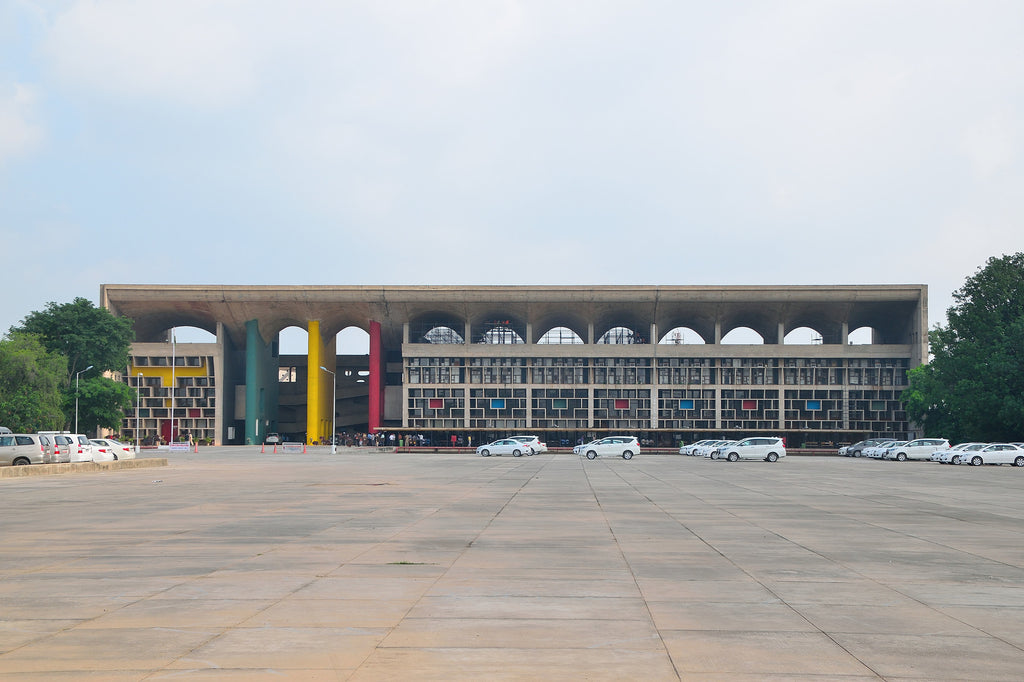Chandigarh is an Indian city known worldwide for realizing the ideals of modernist architecture on an urban scale. Famous architects Le Corbusier and Pierre Jeanneret were deeply involved in creating a new city that symbolized the 20th century.
This article will explain the historical background of Chandigarh's birth, details of city planning, major buildings, and furniture designed by Jeanneret.
History of Chandigarh
Chandigarh is a city located in the foothills of the Himalayas in northern India.
When Punjab was divided into east and west due to the Partition of India and Pakistan in 1947, East Punjab needed a new provincial capital to replace Lahore, which had been incorporated into Pakistan.
In response to this situation, it was decided to build a new state capital, Chandigarh. The name Chandigarh is derived from the temple called 'Chandi Mandir' located near the chosen place.
The city plan for Chandigarh was originally designed by American architect Albert Meyer, but he withdrew from the project midway through due to an unexpected accident. In his place, Le Corbusier took over the city planning, and construction proceeded with the aim of embodying the ideals of modernist architecture, which he achieved.
Chandigarh's architectural complex was registered as a World Heritage Site in 2016, and its historical value is recognized as an ideal urban plan of the 20th century.
Chandigarh urban planning details
Chandigarh's urban structure is unique in that it is likened to the human body. The state building area, where administrative offices are located, is considered the ``head,'' the commercial center is the ``heart,'' and the lush parks and artificial lakes are the ``lungs.''
In addition to these, cultural and educational facilities symbolizing ``intellect'', a road network as a ``circulatory system'', and an industrial area reminiscent of ``internal organs'' are strategically located.
The basic building blocks of Chandigarh are called 'sectors', and each sector consists of 800m x 1200m neighborhoods.
These sectors are designed as self-sufficient communities, including shops, schools, health facilities, etc., and the population of each sector varies depending on size and geography.
In addition, Chandigarh's road system consists of seven categories called ``7V'', which are finely divided by purpose, from expressways to pedestrian roads.
This system was designed to manage traffic flow efficiently and safely. Many green spaces and recreational facilities are located within the city, taking into account the improvement of the quality of life of the citizens.
Today, it is still highly regarded by experts and urban planners around the world for its unique urban planning and is hailed as an innovative example in the field of urban planning.
It is one of the important achievements in 20th century architectural history, realizing the ideals of modernist architecture on a city scale.
Main buildings of Chandigarh

Chandigarh is home to many unique buildings. Of particular note are the iconic buildings located in the Capitol Complex area.
Important government buildings such as the State Capitol, the High Court, and the Administrative Office Building are all located here, and each is considered a masterpiece of modernist architecture.
There are also visually impressive works such as the gigantic monument known as the ``Open Hand'' and the ``Tower of Shadows,'' which have become symbols of the city's design and culture.
Additionally, Chandigarh is rich in cultural institutions such as museums and theaters, which also reflect a unique design philosophy.
About Chandigarh Furniture

Pierre Jeanneret designed various pieces of furniture as part of Chandigarh's urban planning.
Jeanneret's furniture, like its architecture, aims to be simple and functional in design, and its unique shapes such as the "X" and "V" shapes are distinctive.
The chairs and other furniture were made using locally available natural materials such as teak and rattan.
It is said that Jeanneret valued local craft techniques and designed his products while communicating closely with craftsmen.
Because large quantities of furniture were needed at the time, many products were made without Jeanneret's supervision, but only original Jeanneret designs were handmade using advanced techniques.
Currently, Chandigarh furniture in good condition is extremely rare and valuable, and it is prohibited to take it outside India. However, there is a project to recreate this design in a workshop that continues to try to pass on Jeanneret's furniture culture to the next generation.
For those interested in Jeanneret Chandigarh furniture

In this article, we explained the historical background of Chandigarh, India, details of urban planning, famous buildings, and Chandigarh furniture.
" PIERRE JEANNERET TOKYO " sells reproductions of Jeanneret's Chandigarh furniture.
The Chandigarh furniture we handle is carefully manufactured at our factory in India based on Jeanneret's original designs and blueprints.
This factory carefully preserves the precious blueprints and furniture left behind by Jeanneret, and the descendants of the craftsmen who worked at the design office are leading the furniture reproduction project.
All products are made to order and are manufactured and delivered with the utmost care. In addition, we offer after-sales service from our expert technicians, as well as repairs and alterations to your existing Jeanneret products.
If you are interested in Jeanneret's Chandigarh furniture, please take a look at the product illumination.
>>Click here for PIERRE JEANNERET TOKYO products
>>Click here to learn more about PIERRE JEANNERET TOKYO
